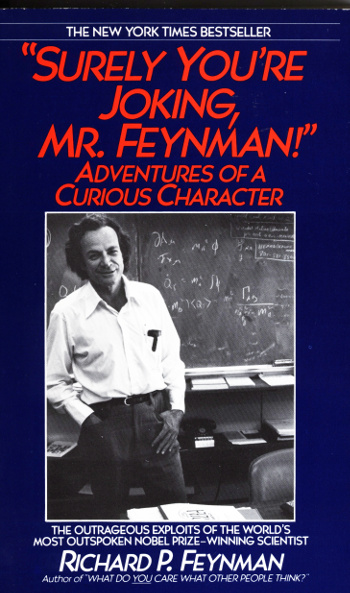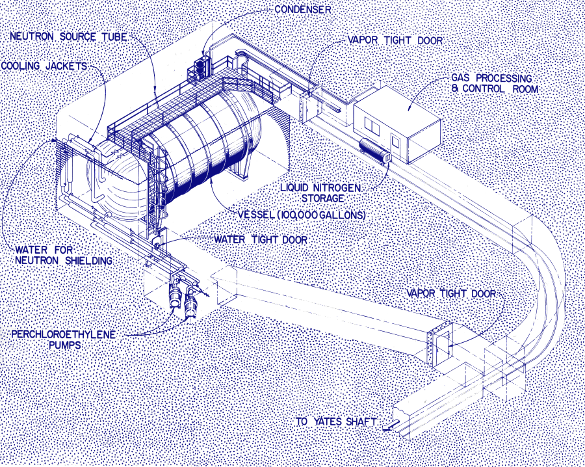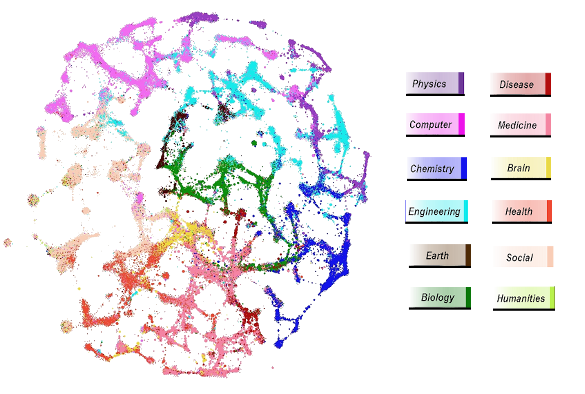Science Awards
September 14, 2020
The
Nobel Prize in Chemistry, and the
Nobel Prize in Physics, each awarded since 1901, are considered to be the pinnacle awards in their respective
scientific fields. The
Wolf Prize has been awarded since 1978 for
chemistry and
physics, and also
mathematics. While the Wolf Prize is a lesser funded award, about $100,000, the million dollar Nobel Prize is often split three-ways. There's an
apocryphal story (
fake news in modern
parlance) that
Alfred Nobel didn't acknowledge
mathematics in his awards, since his
wife had an
affair with a
mathematician. Nobel, however, was never
married.
Even the
monetary award of the Nobel Prize pales beside that of the
Breakthrough Prizes, first awarded in 2012. These prizes, given for
fundamental physics,
life sciences, and mathematics, but not chemistry, are $3 million for each designate. The
Abel Prize, considered the equivalent of a Nobel Prize in Mathematics, has been given annually by the
Norwegian government since 2001. The monetary value of this prize is about $750,000.
There are a
myriad of other prizes given in chemistry and physics, many with monetary awards of about $100,000. However, I've never known a
chemist or
physicist who declared that he or she was working with the objective of winning any prize. I've always thought that the reason for this is the same reason why no respectable scientist buys a
lottery ticket. We're very good at
calculating when the
odds are against us. As one of about 50,000 members of the
American Physical Society, I've never had
delusionss of
glory, especially since my
career was spent doing
applied physics in a
corporate research laboratory.
Most scientists do science for
love, not
money. It's been said that physics and
playing major league baseball are similar
occupations, since their practitioners are
paid to do something that's
enjoyable.
Nobel Physics Laureate,
Richard Feynman (1918-1988), wrote in his 1985
autobiography, "
Surely you're joking, Mr. Feynman, about his fascination with the
wobbling of a
dinner plate thrown in a
cafeteria. He was compelled to
analyze the
mechanics of the problem, "doing it for the fun of it." He wrote that "the whole business that I got the Nobel Prize for came from that piddling around with the wobbling plate."[1]

The cover image of my copy of Richard Feynman's autobiography, "Surely you're joking, Mr. Feynman."[1]
The title of this book comes from the response that Feynman got from his host after his asking for both cream and lemon in his tea at a tea party. This is something I tried as a child only to find the unanticipated result. This was likely the second chemical reaction that I did after mixing baking soda and vinegar.
This autobiography is a much more enjoyable read than James Watson's autobiographical, "The Double Helix."[2]
(Scan of my copy. Click for larger image.)
Many
scientific discoveries worthy of a prize have happened
accidentally; but, as
Louis Pasteur said, "
In the fields of observation chance favours only the prepared mind." Three major physics discoveries, all recognized by a Nobel Prize, were accidental.
X-rays. In 1895,
Wilhelm Röntgen (1845-1923) was conducting
experiments on
emission from
vacuum tubes, such as the
Crookes tube. He discovered an
invisible cathode ray from
aluminum that
excited fluorescence in a
barium salt. Röntgen did multiple experiments on this new
radiation while camped out in his laboratory, where he imaged the
bones in his
hand on a
fluorescent screen. He continued experiments in
secret to ensure the ray's existence before staking his scientific
reputation on this discovery. In 1901, Röntgen was awarded the first Nobel Prize in Physics for the discovery of X-rays, which are sometimes called
Röntgen rays.
Radioactivity. After Röntgen's 1895 discovery of the X-ray,
Henri Becquerel (1852-1908) mounted a search for other rays. Becquerel had been
researching phosphorescence in
materials such as
uranium salts, and he thought that they might emit something like X-rays when activated by
sunlight. He discovered a penetrating radiation from uranium that was independent of exposure to light. For this discovery, Becquerel shared the 1903 Nobel Prize in Physics.
Cosmic Microwave Background Radiation. Bell Labs physicists,
Arno Penzias (b. 1933) and
Robert Woodrow Wilson (b. 1936) were researching sources of
radio interference in
satellite communication in 1964 using a
sensitive horn antenna originally used with the
Echo satellites. After accounting for all known interference sources, they discovered an ubiquitous
noise that was seen over the
entire sky at all times, the source not being from the
Earth, the
Sun, or our
Milky Way Galaxy. They had discovered the remnant radiation from the
Big Bang,
redshifted to
microwave frequencies. Penzias and Wilson were awarded the 1978 Nobel Prize in Physics for this discovery.
One way to make an unique discovery that would likely be award-worthy is to do an experiment that's so difficult that no one else wants to do it, As I wrote in an
earlier article (Bacterial Iron Isotopes, July 22, 2013), that's what physicist,
Raymond Davis, Jr., did in the
1960s. He decided to detect
solar neutrinos in a
gold mine a
mile underground.

A 1972 diagram of the Brookhaven National Laboratory solar neutrino detector used by Raymond Davis, Jr. at the Homestake Mine, Lead, South_Dakota. (Modified Wikimedia Commons image. Click for larger image.)
The first difficulty was the fact that neutrinos don't
interact very often with other
particles. The
neutrino detector of Davis'
Homestake experiment was a tank filled with 100,000
gallons of the common
dry-cleaning chemical,
tetrachloroethylene. Neutrinos, in their infrequent
reaction with the
chlorine nuclei of this
solvent, would produce
argon nuclei. A further difficulty was that Davis needed to count the few argon
atoms thus produced.
It had been predicted that such neutrino interaction would produce just five argon atoms each day. Davis detected just two, discovering
neutrino "flavor" oscillations. Davis shared the
Nobel Prize in Physics in 2002, many years after his experiment. The reason for this is that his discovery needed to be
reproduced. This long delay in certifying Davis' result is further indicative of how
innovative this experiment was.
A recent
open access paper in
PLOS ONE by
researchers from the
Meta-Research Innovation Center at Stanford (METRICS, Stanford, California) and
SciTech Strategies, Inc. (Albuquerque, New Mexico) has examined the last few
decades of the Nobel Prize and found that half of these awards were given in just five research fields.[7-9] They
speculate that such an "honors inequality" affects
research funding by encouraging research in just those fields.[7]
The analysis looked at the key
publication leading to the
Nobel Prize in Physiology or Medicine, the Nobel Prize in Physics, and the Nobel Prize in Chemistry for the period 1995–2017. It was found that these
Nobel Prize papers appeared in just narrow sub-regions of a
cluster map of science created from 63 million published items (see figure).[7-8] There are 114 high-level domains of science, and only 36 have had a Nobel prize.[7-8] Of these, five,
particle physics (14%),
cell biology (12.1%),
atomic physics (10.9%),
neuroscience (10.1%), and
molecular chemistry (5.3%), accounted for 52.4% of the Nobel prizes, despite the fact that those fields account for only about 10 percent of all papers mapped.[7-8]

I must confess that my principal reason for including this image is aesthetics. This is a cluster map of science as shown in 91,726 clusters and associated major scientific disciplines. Images showing where the Nobel Prize papers cluster can be found in ref. 7. (Modified portion of fig.1 of ref. 7, licensed under a Creative Commons Attribution License. Click for larger image.)
Furthermore, nearly all Nobel prize-related papers were
cited less frequently than many other papers published around the same time.[7-8] On
average, there were about 435 more heavily cited papers.[9] The only exception was the 2004 paper on
graphene by
Andre Geim and
Konstantin Novoselov.[10] One consequence of these
statistics is that the Nobel Prize might draw funding to a field, thereby making another Nobel Prize in that field more likely while other fields are ignored.[8] Says paper
author,
John Ioannidis of the Meta-Research Innovation Center at Stanford,
"...It is interesting that while in some subdisciplines 1 out of 1000 publishing scientists may get a Nobel prize, in other subdisciplines no scientist may ever be honored, even though many tens of thousands of scientists work diligently in that subdiscipline."[8]
References:
- Richard P. Feynman and Ralph Leighton, "Surely You're Joking, Mr. Feynman!": Adventures of a Curious Character, W. W. Norton & Company; Reissue edition (February 6, 2018), Paperback, 400 pp., ISBN: 978-0393355628 (via Amazon).
- James D. Watson, "The Double Helix: A Personal Account of the Discovery of the Structure of DNA," Touchstone; First Touchstone Edition edition (June 12, 2001), Paperback, 256 pp., ISBN: 978-0743216302 (via Amazon)
- A.A. Penzias and R.W. Wilson, "A Measurement of Excess Antenna Temperature at 4080 Mc/s.," The Astrophysical Journal, vol. 142, no. 1 (July, 1965) p.419-421, DOI: 10.1086/148307.
- Amit Roy, "Great Experiments in Physics - Discovery of the Cosmic Microwave Background Radiation," Resonance, vol. 5, no. 11 (November, 2000), pp. 4-13.
- Raymond Davis Jr. - Solar Neutrino Experiments, Brookhaven National Laboratory Web Site.
- Solar Neutrinos Are Counted at Brookhaven, Bulletin Board, vol. 21, no. 36 (September 14, 1967), Brookhaven National Laboratory Public Relations Office (PDF File).
- John P. A. Ioannidis, Ioana-Alina Cristea, and Kevin W. Boyack, "Work honored by Nobel prizes clusters heavily in a few scientific fields," PLoS ONE, vol. 15, no. 7 (July 29, 2020), Article no. e0234612, https://doi.org/10.1371/journal.pone.0234612. This is an open access publication with a PDF file here.
- Nobel prize-winning work is concentrated in minority of scientific fields, PLOS Press Release, July 29, 2020.
- Adam Vaughan, "Half of Nobel prizes in science go to just five research fields," New Scientist, July 29, 2020.
- K. S. Novoselov, A. K. Geim, S. V. Morozov, D. Jiang, Y. Zhang, S. V. Dubonos, I. V. Grigorieva, and A. A. Firsov, "Electric Field Effect in Atomically Thin Carbon Films," Science, vol. 306, no. 5696 (October 22 2004), pp. 666-669, DOI: 10.1126/science.1102896.
Linked Keywords: Nobel Prize in Chemistry; Nobel Prize in Physics; scientific field; Wolf Prize; Wolf Prize in Chemistry; Wolf Prize in Physics; Wolf Prize in Mathematics; apocryphal story; fake news; parlance; Alfred Nobel; mathematics; wife; extramarital affair; mathematician; marriage; married; money; monetary; Breakthrough Prize; outline of physics; fundamental physics; life sciences; Abel Prize; Norwegian government; myriad; chemist; physicist; lottery ticket; calculation; calculating; odds; American Physical Society; delusion; glory (honor); career; applied physics; corporate research; laboratory; love; money; playing major league baseball; job; occupation; salary; paid; joy; enjoyable; Nobel Physics Laureate; Richard Feynman (1918-1988); autobiography; Surely you're joking, Mr. Feynman!; wobble; wobbling; dinner plate; throwing; thrown; cafeteria; analysis; analyze; classical mechanics; book cover; image; title (publishing); book; hospitality; host; cream; lemon juice; tea; tea party; child; unintended consequences; unanticipated result; chemical reaction; sodium bicarbonate; baking soda; vinegar; James D. Watson; autobiographical; The Double Helix; scientific discovery; serendipity; accidental; Louis Pasteur; In the fields of observation chance favours only the prepared mind; X-rays; Wilhelm Röntgen (1845-1923); experiment; emission spectrum; vacuum; tube (container); Crookes tube; invisibility; invisible; cathode ray; aluminum; electron excitation; excited; fluorescence; barium; salt (chemistry); ionizing radiation; bone; hand; fluorescent; secrecy; secret; reputation; radioactivity; Henri Becquerel (1852-1908); research; researching; phosphorescence; material; uranium; sunlight; Cosmic Microwave Background Radiation; Bell Labs; Arno Penzias (b. 1933); Robert Woodrow Wilson (b. 1936); electromagnetic interference; radio interference; satellite communication; sensitivity (electronics); horn antenna; Project Echo; Echo satellites; noise; celestial sphere; entire sky; Earth; Sun; Milky Way Galaxy; Big Bang; redshift; redshifted; microwave frequency; Raymond Davis, Jr.; 1960s; solar neutrino; gold mine; mile; Brookhaven National Laboratory solar neutrino detector; diagram; Brookhaven National Laboratory; Homestake Mine (South Dakota); Lead, South Dakota; interaction; interact; elementary particle; neutrino detector; Homestake experiment; gallon; dry-cleaning; chemical; tetrachloroethylene; nuclear reaction; chlorine; atomic nucleus; nuclei; solvent; argon; atom; neutrino "flavor" oscillation; reproducibility; reproduce; innovation; innovative; open access journal; open access paper; PLOS ONE; research; researcher; Meta-Research Innovation Center at Stanford (METRICS, Stanford, California); SciTech Strategies, Inc. (Albuquerque, New Mexico); decade; hypothesis; speculate; funding of science; research funding; scientific literature; publication; Nobel Prize in Physiology or Medicine; cluster analysis; cluster map; particle physics; cell biology; atomic physics; neuroscience; molecular chemistry; aesthetics; science; branches of science; scientific discipline; Creative Commons Attribution License; citation; cited; mean; average; graphene; Andre Geim; Konstantin Novoselov; statistics; author; John Ioannidis.